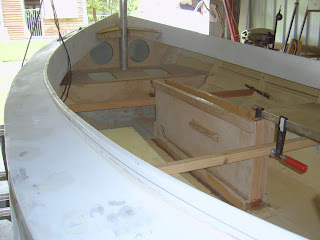I took the Navigator to our "local" fresh water dam (Wivenhoe Dam is Brisbane's main water supply) for its first sail since the refurbishment. The winds were light and variable as a storm front moved in from the west. I managed to get the boat off the water and all packed up for the trip home before the 20 knot winds and heavy rain came in.
So what happened:
Sea Minor launched off the trailer and got back on again without any major problems, However, some fine tuning to the roller and bunk heights is needed and I think I will look at putting wider rollers in place of the two rearmost rollers to better handle the wide section of keel around the centreboard opening.
The centreboard would only go down to about 20% of its fully gown position before the top corner hit the edge of the slot in the top cover of the centreboard case. Nothing that a saw and chisel can't fix but there will be a bit of delay while the varnished top is refuinished. The immediate solution was to remove the cover (it is held in place by screws) so the board could go down.
Several other minor things have to be fixed and I will get those done while the epoxy and varnish are drying on the centrecase top.
The boat sailed nicely but the light wind didn't allow for any serious testing. Here are a couple of photos of the boat in action.
This photo was taken immediately after setting off before the job was unfurled. The eagle eyed will notice that the mainsail is short of a batten in the middle of the sail This batten is in the top pocket and is too short to replace the top batten which I left at home! Even so the sail shape looks OK.
Next photo shows all sails set. Not sure about the mizzen - the sprit boom is a new thing to me and the sail seems to be just hanging there. Maybe I haven't got it sheeted correctly, maybe the light winds aren't helping.
Finally, heading back to the ramp to remove the centreboard case top so the centreboard could go all the way down. Making lots of leeway in this photo!



























